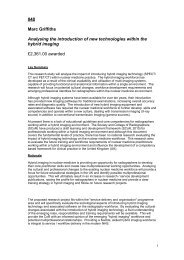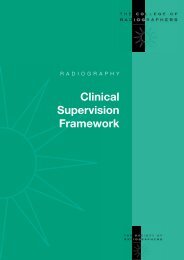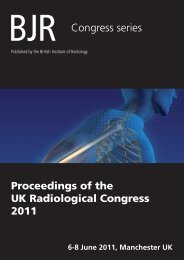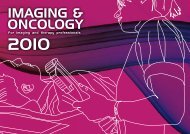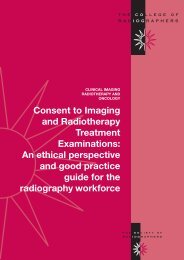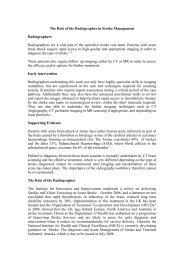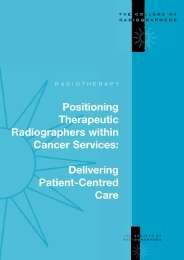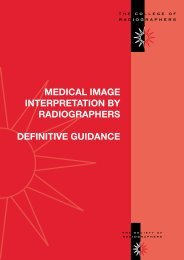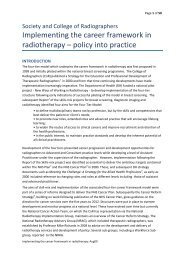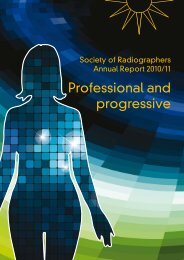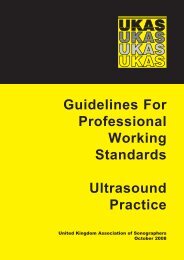Prevention of Work Related Musculoskeletal Disorders in Sonography
Prevention of Work Related Musculoskeletal Disorders in Sonography
Prevention of Work Related Musculoskeletal Disorders in Sonography
Create successful ePaper yourself
Turn your PDF publications into a flip-book with our unique Google optimized e-Paper software.
PREVENTION OF<br />
WORK-RELATED<br />
MUSCULOSKELETAL<br />
DISORDERS IN SONOGRAPHY
PREVENTION OF WORK-RELATED<br />
MUSCULOSKELETAL DISORDERS IN SONOGRAPHY<br />
Society <strong>of</strong> Radiographers’ Responsible Officer:<br />
Kim Sunley<br />
March 2007<br />
First edition<br />
ISBN 0-9503597-8-5<br />
© Society <strong>of</strong> Radiographers<br />
£15 to SCoR members<br />
£25 non-members<br />
The Society <strong>of</strong> Radiographers<br />
207 Providence Square<br />
Mill Street<br />
London SE1 2EW<br />
Telephone: 020 7740 7200<br />
Facsimile: 020 7740 7233<br />
E-mail: <strong>in</strong>fo@sor.org<br />
Website: www.sor.org<br />
3
ACKNOWLEDGEMENTS<br />
The Society <strong>of</strong> Radiographers would like to thank the<br />
follow<strong>in</strong>g members for their <strong>in</strong>put <strong>in</strong>to this document:<br />
Julie Burnage DCR, DMU, FETC<br />
Director, Ultrasound Now Ltd<br />
Ultrasound Now Ltd<br />
Suites 2-3, Hanover House<br />
The Roe, St. Asaph<br />
Denbighshire LL17 0LT<br />
Gillian Cattell DCR, MSc<br />
Advanced Ultrasound Practitioner<br />
Radiology Department<br />
Birm<strong>in</strong>gham Women’s Hospital<br />
Birm<strong>in</strong>gham B15 2TG<br />
Anne-Marie Dixon<br />
Division <strong>of</strong> Radiography<br />
University <strong>of</strong> Bradford<br />
Unity Build<strong>in</strong>g, 25 Tr<strong>in</strong>ity Road<br />
Bradford BD5 0BB<br />
Paul<strong>in</strong>e Kilbourn<br />
Sonographer / H & S Representative SCoR<br />
Ultrasound Dept, City Hospitals<br />
Kayll Road, Sunderland SR4 7TP<br />
Mr Crispian Oates<br />
Head <strong>of</strong> Regional Vascular Ultrasound<br />
Regional Medical Physics Department<br />
Newcastle General Hospital<br />
Dawn Palmer<br />
Senior Sonographer<br />
Ultrasound Department<br />
Radiology<br />
Peterborough Hospitals NHS Trust<br />
Thorpe Road, Peterborough, Cambs. PE36DA<br />
5
Table <strong>of</strong> Contents<br />
Page No.<br />
1. INTRODUCTION 7<br />
2. SCALE OF THE PROBLEM 8<br />
3. THE LEGAL PERSPECTIVE 10<br />
4. HEALTH AND SAFETY MANAGEMENT FRAMEWORK FOR MSDs 14<br />
Understand the issues and commit to action 15<br />
Create the right organisational environment 15<br />
Assess the risk <strong>of</strong> MSDs <strong>in</strong> your workplace 17<br />
Reduce the risk <strong>of</strong> MSDs 19<br />
Educate and <strong>in</strong>form 23<br />
Manage any episodes <strong>of</strong> MSDs 25<br />
Carry out regular checks on programme effectiveness 26<br />
5. RESOURCES 27<br />
Model Risk Assessment<br />
Exercises<br />
Model Policy<br />
6. FURTHER INFORMATION 34<br />
7. REFERENCES 35<br />
6
1. INTRODUCTION<br />
<strong>Musculoskeletal</strong> disorders are the most common work-related illness <strong>in</strong> Brita<strong>in</strong> 1<br />
and represent a<br />
significant potential risk to employers and employees. This guidance focuses on prevent<strong>in</strong>g and<br />
controll<strong>in</strong>g musculoskeletal disorders <strong>in</strong> radiographers and other health care pr<strong>of</strong>essionals engaged <strong>in</strong><br />
sonography. This <strong>in</strong>cludes diffuse conditions affect<strong>in</strong>g the back, shoulders, neck and arms and<br />
localised conditions collectively referred to as work related upper limb disorders affect<strong>in</strong>g a specific area<br />
(such as tendonitis, carpal tunnel syndrome and tenosynovitis).<br />
Advice is given to all parties <strong>in</strong>volved <strong>in</strong> the management and operation <strong>of</strong> sonography facilities<br />
<strong>in</strong>clud<strong>in</strong>g senior managers who have responsibility for sett<strong>in</strong>g policies and ensur<strong>in</strong>g that risks are<br />
elim<strong>in</strong>ated or controlled; departmental managers who can <strong>in</strong>fluence policies and good practice;<br />
specialist advisors such as risk managers, occupational health advisors and back care advisors; safety<br />
representatives and employees who work <strong>in</strong> sonography.<br />
The guidance is relevant to both centralised facilities and satellite units located at the po<strong>in</strong>t <strong>of</strong> care. It<br />
is also applicable to the use <strong>of</strong> ultrasound <strong>in</strong> other environments such as on the ward us<strong>in</strong>g mobile<br />
units, and dur<strong>in</strong>g physiotherapy <strong>in</strong>terventions. It is recommended that this guidance is read <strong>in</strong><br />
conjunction with the Society <strong>of</strong> Radiographers ‘Industry Standards for the <strong>Prevention</strong> <strong>of</strong> <strong>Work</strong> <strong>Related</strong><br />
<strong>Musculoskeletal</strong> <strong>Disorders</strong> <strong>in</strong> <strong>Sonography</strong>’ 2<br />
which details standards and control measures to be taken<br />
to reduce the risk <strong>of</strong> <strong>in</strong>jury.<br />
Other hazards that may be present <strong>in</strong> sonography suites, such as chemicals and electricity, are not<br />
addressed here. These should also be managed through risk assessment and implementation <strong>of</strong><br />
control measures <strong>in</strong> compliance with the relevant statutory requirements e.g. the Management <strong>of</strong><br />
Health and Safety at <strong>Work</strong> Regulations 1999, Control <strong>of</strong> Substances Hazardous to Health Regulations<br />
2002 and the Electricity at <strong>Work</strong> Regulations 1989. Manual handl<strong>in</strong>g is not explored <strong>in</strong> detail although<br />
there is reference to the relevance <strong>of</strong> the regulations <strong>in</strong> relation to musculoskeletal disorders <strong>in</strong><br />
sonographers.<br />
The guidance emphasises the need for managers, safety representatives and employees to work<br />
together to create an environment and culture <strong>in</strong> which safe practices and policies are planned,<br />
implemented, reviewed and ma<strong>in</strong>ta<strong>in</strong>ed.<br />
7
2. SCALE OF THE PROBLEM<br />
The Society <strong>of</strong> Radiographers (SoR) has conducted a number <strong>of</strong> studies <strong>in</strong>to the risks <strong>of</strong><br />
musculoskeletal disorders (MSDs) <strong>in</strong> radiographers and sonographers. A survey <strong>in</strong> 2000 showed that<br />
70% <strong>of</strong> all radiographers and 79% <strong>of</strong> sonographers reported symptoms <strong>of</strong> pa<strong>in</strong> and discomfort they<br />
believed to be work-related (Arrowsmith 2000) 3 .<br />
A further study <strong>of</strong> 300 UK sonographers found a po<strong>in</strong>t prevelance <strong>of</strong> MSDs amongst sonographers to<br />
be 89% (Feather 2001) 4 . This compares with a lifetime prevalence <strong>of</strong> neck and arm pa<strong>in</strong>s <strong>in</strong> the general<br />
population <strong>of</strong> 70% and a po<strong>in</strong>t prevalence <strong>of</strong> between 13 and 22% 5 .<br />
<strong>Musculoskeletal</strong> problems can have a negative impact on both employees affected and the<br />
organisation as a whole. MSDs can be debilitat<strong>in</strong>g and pa<strong>in</strong>ful and can impact on daily liv<strong>in</strong>g. They<br />
can lead to loss <strong>of</strong> morale and possible f<strong>in</strong>ancial hardship if a person has to take time <strong>of</strong>f sick or, <strong>in</strong> a<br />
worse case scenario, has to leave their job as a result <strong>of</strong> the MSD. Furthermore, where a colleague is<br />
<strong>of</strong>f sick, this can have a negative impact on the morale <strong>of</strong> a department <strong>in</strong> terms <strong>of</strong> staff hav<strong>in</strong>g to cope<br />
with an <strong>in</strong>creased work load, which <strong>in</strong> turn has the potential to <strong>in</strong>crease the risk <strong>of</strong> further MSDs <strong>in</strong> staff.<br />
One sonographer, who has been medically retired for two years after one year’s sick leave says: “I don’t<br />
lead a normal life. I can’t do the housework properly and 15 m<strong>in</strong>utes <strong>of</strong> garden<strong>in</strong>g causes dreadful<br />
problems. I can’t sit comfortably for periods <strong>of</strong> time; I haven’t been to the theatre for years and I can’t<br />
even sit and read a book.”<br />
Data from the 1995 Self reported work related illness survey 6 on the work<strong>in</strong>g population <strong>of</strong> Brita<strong>in</strong>,<br />
estimates that a person takes 13 days <strong>of</strong>f work per year as a result <strong>of</strong> a work related upper limb<br />
disorder or neck disorder. In terms <strong>of</strong> the costs to an organisation <strong>of</strong> arrang<strong>in</strong>g temporary agency cover<br />
for a sonographer this could range from £2,700 to £3,700 (based on average 2006 rates for<br />
sonographer agency staff work<strong>in</strong>g a 7 hour day for 13 days ) on top <strong>of</strong> sick pay for the affected<br />
<strong>in</strong>dividual.<br />
Employees return<strong>in</strong>g from sickness absence may also be advised to do reduced hours or have a<br />
phased return to work which could impact on service delivery and patient wait<strong>in</strong>g times.<br />
If the MSD is not recognised or treated <strong>in</strong> time or the causes are not addressed, this could result <strong>in</strong> the<br />
medical retirement <strong>of</strong> a tra<strong>in</strong>ed and experienced sonographer and the subseqent costs which come<br />
with recuruitment and tra<strong>in</strong><strong>in</strong>g a new member <strong>of</strong> staff.<br />
One case <strong>of</strong> MSD <strong>in</strong> the department may just be the ‘tip <strong>of</strong> the iceberg’, if one person is suffer<strong>in</strong>g from<br />
MSDs, there may be the potential for others to be exposed to the risks.<br />
There is also the potential for the healthcare organisation to be prosecuted under health and safety law<br />
and for the <strong>in</strong>jured person to take out a claim for compensation under civil law. In August 2006 a SoR<br />
member who developed an <strong>in</strong>jury to her right arm, shoulder and right side <strong>of</strong> her neck <strong>in</strong> May 2002<br />
8
follow<strong>in</strong>g an <strong>in</strong>crease <strong>in</strong> her workload was awarded a £243,000 out <strong>of</strong> court settlement for an <strong>in</strong>dustrial<br />
<strong>in</strong>jury claim aga<strong>in</strong>st her trust.<br />
The Health and Safety Executive have taken a keen <strong>in</strong>terest <strong>in</strong> the management <strong>of</strong> musculoskeletal<br />
disorders <strong>in</strong> sonography and have issued improvement notices to targetted trusts that have failed to<br />
meet legislative requirements 7 .<br />
Increas<strong>in</strong>g volumes <strong>of</strong> work and demand<strong>in</strong>g work schedules with<strong>in</strong> some organisations, exacerbated<br />
by staff shortages and the pressures <strong>of</strong> work<strong>in</strong>g <strong>in</strong> a target driven environment may have an impact on<br />
the prevalence <strong>of</strong> musculoskeletal disorders <strong>in</strong> sonographers. To date, the impact <strong>of</strong> and association<br />
between workload and symptoms has not been fully researched. However current studies have<br />
<strong>in</strong>dicated that factors such as workload, lack <strong>of</strong> rest breaks and reduced recovery time have an impact<br />
on musculoskeletal symptoms 8, 9, 10, 11, 12, 13 .<br />
9
3. THE LEGAL PERSPECTIVE<br />
There are general duties placed on employers under the Health and Safety at <strong>Work</strong> etc Act 1974 14<br />
and<br />
specific duties to carry out risk assessments under the Management <strong>of</strong> Health and Safety at <strong>Work</strong><br />
Regulations 1999 15 . Other pieces <strong>of</strong> legislation give some reference to the legal standards required to<br />
prevent MSDs and to create an environment that is ergonomically sound and these are mentioned<br />
below.<br />
The Health and Safety at <strong>Work</strong> etc Act 1974<br />
Key duties:<br />
This places general duties upon employers, employees and others:<br />
Employers must:<br />
• protect the health and safety <strong>of</strong> their employees [Section 2(1)]<br />
• protect the health and safety <strong>of</strong> others who might be affected by the way they go about their<br />
work (for example, cleaners, visitors or contractors work<strong>in</strong>g <strong>in</strong> the hospital) [Section 3(1)]<br />
• prepare a statement <strong>of</strong> safety policy and the organisation and arrangements for carry<strong>in</strong>g it out<br />
(if 5 or more people are employed, this statement must be written down) [Section 2(3)]<br />
Employees must:<br />
• take care <strong>of</strong> their own health and safety and that <strong>of</strong> others [Section 7(a)]<br />
• co-operate with their employer [Section 7(b)]<br />
The general duties <strong>in</strong> the Health and Safety at <strong>Work</strong> Act are developed <strong>in</strong> the Management <strong>of</strong> Health<br />
and Safety at <strong>Work</strong> Regulations 1999 (the Management Regulations) and other more specific pieces <strong>of</strong><br />
law. The Approved Code <strong>of</strong> Practice on the Management <strong>of</strong> Health and Safety at <strong>Work</strong> Regulations 15<br />
provides further guidance.<br />
The Management <strong>of</strong> Health and Safety at <strong>Work</strong> Regulations 1999<br />
Key duties:<br />
Employers must:<br />
• assess risks to staff and others, <strong>in</strong>clud<strong>in</strong>g visitors, young persons and new and expectant<br />
mothers. [Regulation 3(1)]<br />
• make appropriate health and safety arrangements, which must be written down if 5 or more<br />
people are employed [Regulation 5]<br />
• appo<strong>in</strong>t competent persons to help them comply with health and safety law [Regulation 7(1)]<br />
10
• establish procedures to deal with imm<strong>in</strong>ent danger [Regulation 8]<br />
• co-operate and co-ord<strong>in</strong>ate with other employers and self-employed persons who share the<br />
workplace (for example primary care trust staff work<strong>in</strong>g at an acute trust site or vice versa)<br />
[Regulation 11]<br />
Employees must:<br />
• work <strong>in</strong> accordance with tra<strong>in</strong><strong>in</strong>g and <strong>in</strong>struction given by their employer [Regulation 14(1)]<br />
• report situations which they believe to be unsafe [Regulation 14 (2)]<br />
The legal framework lays down a hierarchy <strong>of</strong> measures [Regulation 4 and Schedule 1]:<br />
(a)<br />
(b)<br />
(c)<br />
Avoid hazardous operations so far as is reasonably practicable. This may be done by<br />
redesign<strong>in</strong>g the task to avoid the hazard e.g. through automation.<br />
Make a suitable and sufficient risk assessment <strong>of</strong> any work activities where the risk cannot be<br />
avoided.<br />
Reduce the risk <strong>of</strong> <strong>in</strong>jury from those operations so far as is reasonably practicable by changes<br />
to the, equipment, work<strong>in</strong>g practices and the work<strong>in</strong>g environment.<br />
Health and Safety (Display Screen Equipment) Regulations 1992<br />
In a survey <strong>of</strong> 55 sonographers <strong>in</strong> 2002 (SoR) 16 , 84% reported spend<strong>in</strong>g over 6 hours per day scann<strong>in</strong>g<br />
patients. Additionally 35.3% <strong>of</strong> respondents typed patient reports on a computer. This figure is likely to<br />
<strong>in</strong>crease significantly as further IT systems are <strong>in</strong>stalled.<br />
Many sonographers will, therefore, be “users” or “operators” and subject to the provisions <strong>of</strong> the<br />
Display Screen Equipment Regulations. This is supported by the Health and Safety Executive <strong>in</strong> their<br />
guidance to <strong>in</strong>spectors 7 .<br />
The Display Screen Equipment Regulations require employers to:<br />
• assess and reduce risks from display screen work;<br />
• ensure workstations meet m<strong>in</strong>imum requirements, as laid out <strong>in</strong> the schedule to the<br />
regulations;<br />
• plan breaks or changes <strong>of</strong> activity;<br />
• provide health and safety tra<strong>in</strong><strong>in</strong>g and <strong>in</strong>formation and provide eye tests on request and<br />
glasses if required for display screen work.<br />
More detailed guidance on Display Screen Equipment can be found <strong>in</strong> the SoR’s guide VDUser<br />
Friendly 17 and the HSE’s Guidance on the Health and Safety (Display Screen Equipment) Regulations<br />
1992 18 .<br />
11
Consult<strong>in</strong>g employees<br />
Two pieces <strong>of</strong> health and safety law cover consultation with employees. The Safety Representatives<br />
and Safety Committees Regulations 1977 deal with consult<strong>in</strong>g recognised trade unions through their<br />
safety representatives and the Health and Safety (Consultation with Employees) Regulations 1996<br />
cover employees who do not have a trade union safety representative or where the employer does not<br />
recognise a union. More detailed guidance is provided <strong>in</strong> other HSE publications 19, 20 and on the TUC<br />
website 21 .<br />
Employers must consult employees and their representatives about aspects <strong>of</strong> their health and<br />
safety at work, <strong>in</strong>clud<strong>in</strong>g:<br />
• any change which may substantially affect their health and safety;<br />
• their employer's arrangements for gett<strong>in</strong>g competent health and safety advice;<br />
• the <strong>in</strong>formation provided on reduc<strong>in</strong>g and deal<strong>in</strong>g with risks;<br />
• the plann<strong>in</strong>g <strong>of</strong> health and safety tra<strong>in</strong><strong>in</strong>g;<br />
• the health and safety consequences <strong>of</strong> <strong>in</strong>troduc<strong>in</strong>g new technology.<br />
Arrangements for deal<strong>in</strong>g with risks <strong>of</strong> MSDs <strong>in</strong> sonography suites are only fully effective if employers<br />
closely <strong>in</strong>volve employees and their representatives.<br />
In addition, recognised trade union safety representatives have the right to:<br />
• carry out regular workplace <strong>in</strong>spections (every 3 months or more <strong>of</strong>ten <strong>in</strong> the event <strong>of</strong> a safety<br />
concern or accident);<br />
• receive <strong>in</strong>formation from the employer on a health and safety issue (there are certa<strong>in</strong><br />
exceptions to this e.g. <strong>in</strong>formation relat<strong>in</strong>g specifically to an <strong>in</strong>dividual, unless the <strong>in</strong>dividual<br />
has given their consent);<br />
• <strong>in</strong>vestigate accidents and cases <strong>of</strong> ill health;<br />
• to be consulted <strong>in</strong> good time on matters relat<strong>in</strong>g to health and safety;<br />
• to request the establishment <strong>of</strong> a safety committee (where two or more safety representatives<br />
put this <strong>in</strong> writ<strong>in</strong>g).<br />
12
The Report<strong>in</strong>g <strong>of</strong> Injuries, Diseases and Dangerous Occurrences 1995<br />
The Report<strong>in</strong>g <strong>of</strong> Injuries, Diseases and Dangerous Occurrences Regulations 1995 (RIDDOR) require<br />
employers to report specified accidents and dangerous occurrences and cases <strong>of</strong> ill health to the HSE.<br />
Occupational diseases <strong>in</strong>clude cramp <strong>of</strong> the hand or forearm due to repetitive movements. The cramp<br />
must be a chronic condition l<strong>in</strong>ked to repetitive work movements and usually characterised by the<br />
<strong>in</strong>ability to carry out a sequence <strong>of</strong> what were previously well co-ord<strong>in</strong>ated movements. Further<br />
<strong>in</strong>formation and guidance is available from the HSE’s guide to the Report<strong>in</strong>g <strong>of</strong> Injuries, Diseases and<br />
Dangerous Occurrences Regulations 1995 22 .<br />
<strong>Work</strong>place (Health, Safety and Welfare) Regulations 1992<br />
The <strong>Work</strong>place (Health, Safety and Welfare) Regulations 1992 require workplaces to meet certa<strong>in</strong><br />
standards with regards to the environment and facilities.<br />
With regards to the prevention <strong>of</strong> MSDs, two sections <strong>of</strong> the regulations are relevant. They require that:<br />
• light<strong>in</strong>g is sufficient to enable people to work and use facilities safely;<br />
• temperatures <strong>in</strong> <strong>in</strong>door workplaces are reasonable.<br />
Further <strong>in</strong>formation on the regulations can be found <strong>in</strong> the HSE’s guidance and approved code <strong>of</strong><br />
practice 23 .<br />
Provision and Use <strong>of</strong> <strong>Work</strong> Equipment Regulations 1998<br />
The Provision and Use <strong>of</strong> <strong>Work</strong> Equipment Regulations 1998 apply to different types <strong>of</strong> work equipment<br />
from hand tools to mach<strong>in</strong>ery. Ultrasound equipment is covered by these regulations. Under the<br />
regulations employers are required to take <strong>in</strong>to account the ergomonic risks when select<strong>in</strong>g work<br />
equipment [Regulation 4] (i.e. to ensure that equipment and operat<strong>in</strong>g positions; work<strong>in</strong>g heights; reach<br />
distances are compatible with the <strong>in</strong>tended operator). The approved code <strong>of</strong> practice and guidance on<br />
the regulations is available from the HSE 24 .<br />
The Manual Handl<strong>in</strong>g Operations Regulations 1992<br />
These regulations are primarily aimed at lift<strong>in</strong>g and mov<strong>in</strong>g operations, however they are also relevant<br />
to MSDs and stra<strong>in</strong> <strong>in</strong>juries. The Approved Code <strong>of</strong> Practice accompany<strong>in</strong>g these Regulations 25 states:<br />
“Spra<strong>in</strong>s and stra<strong>in</strong>s arise from <strong>in</strong>correct application and/or prolongation <strong>of</strong> bodily force. Poor posture<br />
and excessive repetitive movement can be important factors <strong>in</strong> their onset. Many manual handl<strong>in</strong>g<br />
<strong>in</strong>juries are cumulative rather than be<strong>in</strong>g truly attributable to any s<strong>in</strong>gle handl<strong>in</strong>g <strong>in</strong>cident.”<br />
13
4. HEALTH AND SAFETY MANAGEMENT FRAMEWORK<br />
The Health and Safety Executive (HSE) have developed a seven stage cycle to assist with the<br />
management <strong>of</strong> work related upper limb disorders 26 . The cycle takes an ergonomic approach which<br />
<strong>in</strong>cludes the participation and <strong>in</strong>volvement <strong>of</strong> the workforce.<br />
The cycle is detailed <strong>in</strong> Table 1. The cycle provides a robust framework for employers to follow when<br />
implement<strong>in</strong>g a risk management programme for MSDs <strong>in</strong> sonography departments. The next section<br />
<strong>of</strong> this guide details each step <strong>of</strong> the cycle and practical action that can be taken.<br />
1. Understand the issues and commit to action<br />
2. Create the right organisational environment<br />
3. Assess the risk <strong>of</strong> MSDs <strong>in</strong> your workplace<br />
4. Reduce the risks <strong>of</strong> MSDs<br />
5. Educate and <strong>in</strong>form<br />
6. Manage any episodes <strong>of</strong> MSDs<br />
7. Carry out regular checks on programme effectiveness<br />
Table 1. Risk Management Programme for MSD’s.<br />
14
Step 1. UNDERSTAND THE ISSUES AND COMMIT TO ACTION<br />
The HSE recommend that management and workers should have an understand<strong>in</strong>g <strong>of</strong> the issues and<br />
be committed to action on prevention. This commitment may be expressed through strong leadership,<br />
by generat<strong>in</strong>g an effective health and safety policy and by hav<strong>in</strong>g appropriate systems <strong>in</strong> place. These<br />
actions will help to promote a positive health and safety culture <strong>in</strong> the workplace. The HSE also<br />
emphasise that effective management <strong>of</strong> occupational health risks is characterised by “an appropriate<br />
balance between health and safety and production goals”.<br />
Jo<strong>in</strong>t commitment from managers and safety representatives and sign up to a local action plan is an<br />
excellent way <strong>of</strong> mov<strong>in</strong>g forward.<br />
Case Study: Committ<strong>in</strong>g to action and creat<strong>in</strong>g the right organisational environment through<br />
participation and <strong>in</strong>volvement<br />
As a result <strong>of</strong> recommendations made by the Health and Safety Executive, follow<strong>in</strong>g a visit to the<br />
ultrasound department at City Hospitals Sunderland <strong>in</strong> January 2002, an action plan was developed.<br />
One <strong>of</strong> the first actions was to set up an assessment team to <strong>in</strong>vestigate the issues and undertake a<br />
detailed risk assessment. The assessment team consisted <strong>of</strong> the radiology bus<strong>in</strong>ess manager, the<br />
ultrasound super<strong>in</strong>tendent, a sonographer/health and safety representative, an occupational health<br />
nurse and a back care physiotherapist.<br />
(Source: “Reduc<strong>in</strong>g the health risks to sonographers” by Paul<strong>in</strong>e Kilbourn Synergy March 2004)<br />
Suggested Action:<br />
• Sign up to a jo<strong>in</strong>t action plan on implement<strong>in</strong>g a risk management programme<br />
Step 2. CREATE THE RIGHT ORGANISATIONAL ENVIRONMENT<br />
The HSE identify four ways <strong>of</strong> creat<strong>in</strong>g the right organisational environment:<br />
• Participation and <strong>in</strong>volvement<br />
• Communication<br />
• Competence<br />
• Allocation <strong>of</strong> responsiblities<br />
Participation and <strong>in</strong>volvement<br />
Participation is well documented as a factor necessary for the success <strong>of</strong> any workplace ergonomic<br />
programme.<br />
15
Participation and <strong>in</strong>volvement <strong>of</strong> safety representatives and employees is key to the prevention <strong>of</strong><br />
MSDs. Safety representatives can give managers a ‘reality check’ as to what conditions are like. Safety<br />
representatives can also provide an effective channel for employees to report concerns and equally to<br />
act as a conduit for managers <strong>in</strong> communicat<strong>in</strong>g important safety messages to employees.<br />
Communication<br />
Communication with<strong>in</strong> the department and the wider organisation is also key, <strong>in</strong>clud<strong>in</strong>g communication<br />
with those <strong>in</strong>volved <strong>in</strong> the purchase <strong>of</strong> equipment and design <strong>of</strong> new builds or refurbishments which<br />
could impact on MSDs e.g. space and layout <strong>of</strong> scann<strong>in</strong>g facilities.<br />
Competence<br />
Managers, safety representatives, employees and specialist staff such as risk managers need to be<br />
competent <strong>in</strong> order to prevent MSDs. The HSE recommend that some groups <strong>of</strong> staff may require<br />
specialised tra<strong>in</strong><strong>in</strong>g e.g. <strong>in</strong> the application <strong>of</strong> ergonomic pr<strong>in</strong>ciples, evaluation <strong>of</strong> workplace changes<br />
and the recognition <strong>of</strong> MSDs. The HSE also recommends that prevention <strong>of</strong> MSDs is an <strong>in</strong>tegral part<br />
<strong>of</strong> health and safety tra<strong>in</strong><strong>in</strong>g, pay<strong>in</strong>g particular attention to risk factors and how these may be avoided.<br />
Access to specialist ergonomic advice will not always be necessary and many problems can be solved<br />
with a multi-discipl<strong>in</strong>ary approach, which <strong>in</strong>cludes safety representatives and back care advisors.<br />
However, where complex issues cannot be solved locally, the advice <strong>of</strong> an ergomonist may need to be<br />
sought.<br />
Allocation <strong>of</strong> responsiblities<br />
Legal responsibility for health and safety <strong>in</strong> the sonography suite cannot be delegated and rests<br />
primarily with the employer. This <strong>in</strong>volves assessment <strong>of</strong> the risks, development <strong>of</strong> policies, putt<strong>in</strong>g<br />
arrangements <strong>in</strong> place to implement those policies and monitor<strong>in</strong>g the way those arrangements work.<br />
Effective management can only be achieved through <strong>in</strong>volvement <strong>of</strong> the l<strong>in</strong>e management cha<strong>in</strong>. Action<br />
to ensure that adequate precautions are <strong>in</strong> place is generally delegated down to l<strong>in</strong>e managers.<br />
Suggested Action:<br />
• Introduce the draft action plan at a staff meet<strong>in</strong>g and ask for feedback<br />
• Communicate your action plan and risk management programme with <strong>in</strong>ternal<br />
stakeholders <strong>in</strong>clud<strong>in</strong>g estates and facilities and procurement<br />
• Assess the competencies and tra<strong>in</strong><strong>in</strong>g needs <strong>of</strong> those <strong>in</strong>volved <strong>in</strong> implement<strong>in</strong>g the<br />
programme and provide tra<strong>in</strong><strong>in</strong>g where gaps have been identified<br />
• Develop a local policy on prevention and management <strong>of</strong> MSDs<br />
• Ensure that everyone is clear about their responsibilities<br />
16
Step 3. ASSESSING THE RISKS OF MSDS IN THE WORKPLACE<br />
Risk assessment is not simply a paper exercise. Its purpose is to ensure that there are appropriate<br />
precautions <strong>in</strong> place. Risk assessment <strong>in</strong>volves systematically look<strong>in</strong>g at the work to identify the<br />
significant risks and determ<strong>in</strong>e the precautions needed to elim<strong>in</strong>ate or control these risks. It can be<br />
simplified <strong>in</strong>to a five step process:<br />
Step one: look for hazards<br />
Step two: identify who might be harmed and how<br />
Step three: evaluate the risks - consider the exist<strong>in</strong>g controls and assess the extent <strong>of</strong> the risks<br />
which rema<strong>in</strong><br />
Step four: record the f<strong>in</strong>d<strong>in</strong>gs <strong>of</strong> the assessment <strong>in</strong>clud<strong>in</strong>g the controls necessary and any further<br />
action needed to reduce risk sufficiently<br />
Step five: review, revise and modify the assessment particularly if the nature <strong>of</strong> the work changes<br />
or if developments suggest that it may no longer be valid<br />
Assessments should be carried out by people tra<strong>in</strong>ed to do so and with knowledge <strong>of</strong> the work <strong>of</strong> the<br />
unit. Safety representatives are crucial to the process. In some <strong>in</strong>stances ergonomic expertise may also<br />
be required.<br />
Risk factors<br />
When assess<strong>in</strong>g musculoskeletal hazards from sonography, the follow<strong>in</strong>g risk factors should be taken<br />
<strong>in</strong>to account:<br />
<strong>Work</strong><strong>in</strong>g postures adopt<strong>in</strong>g dur<strong>in</strong>g scann<strong>in</strong>g<br />
Design features <strong>of</strong> ultrasound equipment such as:<br />
o Adjustability <strong>of</strong> equipment <strong>in</strong>clud<strong>in</strong>g monitor, <strong>in</strong> terms <strong>of</strong> height and tilt<br />
o Keyboard design for comfort<br />
o S<strong>of</strong>tware dictates the number <strong>of</strong> movements needed by the operator<br />
o Probe/transducer size, weight, slip resistance, ease <strong>of</strong> handl<strong>in</strong>g to reduce p<strong>in</strong>ch grip<br />
o Cable weight and support<br />
o Mobility, stability and ease <strong>of</strong> manoeuvr<strong>in</strong>g the mach<strong>in</strong>e<br />
o Fitness for purpose<br />
Furniture such as adjustable chairs and tables/exam<strong>in</strong>ation couches for<br />
• Support<br />
• Mobility<br />
17
Accessory equipment such as<br />
• Pr<strong>in</strong>ters<br />
• Image storage devices<br />
• Transducer clean<strong>in</strong>g facilities<br />
• Patient support pads<br />
• Accessibility <strong>of</strong> gel and paper roll<br />
• Additional external/slave monitors<br />
Job design<br />
• Schedul<strong>in</strong>g <strong>of</strong> breaks and are they actually taken?<br />
• Length <strong>of</strong> patient lists/workload<br />
• Mixed case load or repetition <strong>of</strong> same procedure<br />
• Overtime work<strong>in</strong>g<br />
• Staff rotation<br />
• M<strong>in</strong>i and microbreaks<br />
• Is there control over workflow?<br />
Environmental factors<br />
• Heat<strong>in</strong>g<br />
• Light<strong>in</strong>g<br />
• Space constra<strong>in</strong>ts<br />
• Provision for wheelchair and trolley access<br />
Education and tra<strong>in</strong><strong>in</strong>g<br />
• Staff tra<strong>in</strong><strong>in</strong>g <strong>in</strong> risks and control measures<br />
• Understand<strong>in</strong>g <strong>of</strong> report<strong>in</strong>g mechanisms<br />
Psychological Stressors<br />
• Introduction and familiarisation with new technology<br />
• Impact <strong>of</strong> carry<strong>in</strong>g out scans which show fetal demise or abnormality<br />
Suggested Action:<br />
• Identify the risks <strong>in</strong> your department<br />
• Ensure that all parties <strong>in</strong>clud<strong>in</strong>g managers, safety representatives, specialist staff and<br />
employees are <strong>in</strong>volved <strong>in</strong> identify<strong>in</strong>g risks<br />
18
Step 4. REDUCE THE RISK OF MSDS<br />
RISK CONTROL MEASURES<br />
The risk <strong>of</strong> MSDs can be managed by a package <strong>of</strong> measures which must be designed and<br />
implemented <strong>in</strong> collaboration with relevant parties. This may <strong>in</strong>clude departmental managers,<br />
sonographers, safety representatives, back care advisory service, occupational health service, health<br />
and safety department, estates, purchas<strong>in</strong>g department and equipment suppliers.<br />
The SoR document entitled ‘Industry Standards for the <strong>Prevention</strong> <strong>of</strong> <strong>Work</strong> <strong>Related</strong> <strong>Musculoskeletal</strong><br />
<strong>Disorders</strong> <strong>in</strong> <strong>Sonography</strong>’ 2<br />
should be referred to when implement<strong>in</strong>g control measures.<br />
The measures to be considered should <strong>in</strong>clude:<br />
• A clear policy for the reduction <strong>of</strong> musculoskeletal hazards which is endorsed at Board level<br />
and with a commitment to identify and control risks. The policy should <strong>in</strong>clude the<br />
arrangements <strong>in</strong> place to conduct risk assessments, record the significant f<strong>in</strong>d<strong>in</strong>gs and<br />
means <strong>of</strong> identify<strong>in</strong>g when re-assessment is needed.<br />
• Evaluation <strong>of</strong> the ergonomic design <strong>of</strong> ultrasound equipment which should be given a high<br />
priority <strong>in</strong> the decision to purchase/lease.<br />
• The use <strong>of</strong> voice activated s<strong>of</strong>tware which elim<strong>in</strong>ates much keyboard work.<br />
• Ergonomic assessment <strong>of</strong> exist<strong>in</strong>g equipment and modifications to reduce risk e.g. plac<strong>in</strong>g<br />
equipment on a height adjustable table.<br />
• Provision <strong>of</strong> adjustable chairs that support the back, legs and feet and promote an upright<br />
posture.<br />
• Exam<strong>in</strong>ation tables that are height adjustable, and allow staff to get as close as possible to<br />
the patient. Special features may be available for particular procedures e.g. a drop away or<br />
cut out section for ease <strong>of</strong> access to the apical region for cardiac imag<strong>in</strong>g and an adjustable<br />
footplate for trans-vag<strong>in</strong>al exam<strong>in</strong>ations.<br />
• Accessories such as a transducer cable support, operator forearm support, and plac<strong>in</strong>g <strong>of</strong><br />
items such as gel bottles, record<strong>in</strong>g devices with<strong>in</strong> easy reach.<br />
• Remote monitors to prevent unnecessary twist<strong>in</strong>g, bend<strong>in</strong>g and turn<strong>in</strong>g to view monitor as is<br />
especially common <strong>in</strong> vascular scann<strong>in</strong>g.<br />
• Ma<strong>in</strong>tenance regimes <strong>in</strong> place to ensure that equipment and the work<strong>in</strong>g environment are<br />
kept <strong>in</strong> good work<strong>in</strong>g order. A system for report<strong>in</strong>g faults should be <strong>in</strong> place.<br />
• Management <strong>of</strong> patient lists to enable task rotation.<br />
19
• Protocols for exam<strong>in</strong>ation <strong>of</strong> high BMI patients and to <strong>in</strong>form referrers and patients <strong>of</strong> the<br />
limitations <strong>of</strong> exam<strong>in</strong>ations.<br />
• Staff<strong>in</strong>g levels and skill mix.<br />
• <strong>Work</strong> schedul<strong>in</strong>g, <strong>in</strong>clud<strong>in</strong>g schedul<strong>in</strong>g <strong>of</strong> breaks or changes <strong>in</strong> activity. Short frequent breaks<br />
e.g. 5 – 10 m<strong>in</strong>utes after 50 – 60 m<strong>in</strong>utes cont<strong>in</strong>uous screen/keyboard work are considered<br />
better than a 15 m<strong>in</strong>ute break every 2 hours. For further <strong>in</strong>formation see section on work<br />
schedul<strong>in</strong>g.<br />
• Ensur<strong>in</strong>g the work<strong>in</strong>g environment is suitable e.g. light<strong>in</strong>g, floor<strong>in</strong>g, housekeep<strong>in</strong>g,<br />
temperature and noise.<br />
• Exercise to reduce and relieve muscle stress (examples <strong>of</strong> exercises can be found on page<br />
28).<br />
Case Study: Equipment Purchase<br />
As part <strong>of</strong> a medical equipment replacement programme, three new mach<strong>in</strong>es were purchased.<br />
With<strong>in</strong> the procurement process, manufacturers were <strong>in</strong>formed <strong>of</strong> the need for the equipment to be<br />
ergonomically suitable. The mach<strong>in</strong>es were assessed us<strong>in</strong>g specific criteria. Several mach<strong>in</strong>es failed<br />
to obta<strong>in</strong> a good ergonomic rat<strong>in</strong>g. The two mach<strong>in</strong>es, that did perform well, were the most expensive<br />
<strong>of</strong> those assessed. The Directorate put together a bus<strong>in</strong>ess case to purchase this more expensive<br />
equipment, justified on the basis <strong>of</strong> cost benefit. The benefit <strong>of</strong> the ergonomic design, with reduced<br />
risk <strong>of</strong> <strong>in</strong>jury, far outweighed the additional added cost to purchase the equipment.<br />
(Source: “Reduc<strong>in</strong>g the health risks to sonographers” by Paul<strong>in</strong>e Kilbourn, Synergy March 2004)<br />
Health and Safety Executive Case Study<br />
A Health and Safety Executive research report published <strong>in</strong> October 2006 on the cost benefits <strong>of</strong><br />
tackl<strong>in</strong>g musculoskeletal disorders details two case studies carried out <strong>in</strong> sonography. The<br />
ergonomists carry<strong>in</strong>g out the research on behalf <strong>of</strong> the HSE found that <strong>in</strong>terventions <strong>in</strong>clud<strong>in</strong>g the use<br />
<strong>of</strong> a saddle seat, reduction <strong>in</strong> number <strong>of</strong> scans from 30 to 20 per day, tra<strong>in</strong><strong>in</strong>g on good posture,<br />
exercises and giv<strong>in</strong>g sonographers more control <strong>of</strong> the book<strong>in</strong>g system significantly reduced<br />
compla<strong>in</strong>ts <strong>of</strong> upper limb discomfort over a 6 month period. The study also highlighted the cost benefits<br />
<strong>of</strong> such an <strong>in</strong>tervention.<br />
Source: Cost Benefit studies that support tackl<strong>in</strong>g musculoskeletal disorders (HSE Research Report 491) 27 , conta<strong>in</strong>s several<br />
other case studies, <strong>in</strong>clud<strong>in</strong>g one on medical film exam<strong>in</strong>ation workstations used by radiologists.<br />
20
Case Study<br />
Risk Assessment<br />
• Individual work place assessments for sonographers<br />
• Saddle seat available on all sites<br />
• Arm braces available<br />
• Specific tailor made manual handl<strong>in</strong>g assessments for ultrasound<br />
• Assistants to work with sonographers <strong>in</strong> most areas to take away non-essential computer<br />
work/organis<strong>in</strong>g to reduce stress levels<br />
Source: Peterborough Hospital NHS Trust<br />
<strong>Work</strong> Schedul<strong>in</strong>g<br />
<strong>Work</strong> schedul<strong>in</strong>g and hands on transducer time are key factors to consider when implement<strong>in</strong>g a risk<br />
management programme. There are two <strong>in</strong>terrelated levels where workload needs to be controlled and<br />
where absence <strong>of</strong> control is likely to produce both psychological stress and MSD <strong>in</strong>jury. The first <strong>of</strong><br />
these is the number <strong>of</strong> scans and the scan-type mix booked <strong>in</strong>to a session. The second is hav<strong>in</strong>g the<br />
ability to control the rate <strong>of</strong> book<strong>in</strong>g and throughput. The potential <strong>of</strong> too many scans with a lack <strong>of</strong><br />
control <strong>of</strong> throughput, produc<strong>in</strong>g unsafe workloads, is exacerbated by the <strong>in</strong>creas<strong>in</strong>g demand on a<br />
service with limited staff and equipment resources, and the use <strong>of</strong> external book<strong>in</strong>g arrangements, for<br />
example outpatient services book<strong>in</strong>g patients on a patient-choice basis, with no regard to scan type or<br />
what is asked for on the request card. Whilst external pressures mean that government targets have<br />
to be achieved, they should not be pursued at all costs, particularly at the cost to a sonographer's<br />
health and well-be<strong>in</strong>g.<br />
When schedul<strong>in</strong>g work, many factors must be taken <strong>in</strong>to consideration <strong>in</strong>clud<strong>in</strong>g the experience <strong>of</strong> the<br />
sonographer; standards <strong>of</strong> equipment <strong>in</strong> use; type <strong>of</strong> scan be<strong>in</strong>g carried out; BMI <strong>of</strong> patient; need to<br />
plan for micro breaks and lunch breaks; the availability <strong>of</strong> an assistant; the use <strong>of</strong> new technology and<br />
psychological factors <strong>in</strong>clud<strong>in</strong>g scans <strong>in</strong>dicat<strong>in</strong>g foetal demise and abnormalities.<br />
Departmental managers, safety representatives and sonographer's should work together to agree a<br />
safe work schedule over which the sonographer has a considerable degree <strong>of</strong> control. Hav<strong>in</strong>g agreed<br />
a reasonable book<strong>in</strong>g/request acceptance protocol, with regard to demand, resources available and<br />
safe work<strong>in</strong>g practices, it should be rigorously adhered to and kept under review. This will need to take<br />
<strong>in</strong>to account the expected workload result<strong>in</strong>g from planned outpatient appo<strong>in</strong>tments and the less<br />
predictable <strong>in</strong>patient and urgent workload. Whilst the manager, with<strong>in</strong> the exigencies <strong>of</strong> the whole<br />
service, has a duty <strong>of</strong> care to ensure that staff are not put at risk, each sonographer has a duty <strong>of</strong> care<br />
to themselves and their colleagues not to jeopardise their ability to cont<strong>in</strong>ue their practice through<br />
MSDs. The onus to agree or to refuse to do extra scans over and above the agreed schedule should<br />
be the responsibility <strong>of</strong> the <strong>in</strong>dividual sonographer who will perform the scan, without prejudice. In<br />
some cases it may be necessary to advise a sonographer not to do more than is a sensible or<br />
reasonable amount.<br />
21
Case study<br />
The <strong>in</strong>patient workload runs at an average <strong>of</strong> 34% <strong>of</strong> the total number <strong>of</strong> scans performed each month.<br />
The number <strong>of</strong> slots kept free for <strong>in</strong>patients <strong>in</strong> a full session is 34%, with the time <strong>of</strong> slots equal to the<br />
average scan time. This results <strong>in</strong> some busy days and some less busy days that averages out over a<br />
month. If a doctor phones to have an extra patient seen from the cl<strong>in</strong>ic, the person who will perform<br />
the scan has the right to accept the decl<strong>in</strong>e the scan or agree with a colleague that they will do it, or<br />
suggested to the doctor that an early outpatient appo<strong>in</strong>tment will be made for the patient. They are<br />
supported <strong>in</strong> their decision by the departmental manager. The rate <strong>of</strong> <strong>in</strong>patient requests and agreed<br />
book<strong>in</strong>g rates are kept under regular review. Book<strong>in</strong>g rates are adjusted for scan type, tra<strong>in</strong><strong>in</strong>g<br />
sessions, <strong>in</strong>experienced sonographers and availability <strong>of</strong> HCA assistance.<br />
Source: Crispian Oates, Head <strong>of</strong> Regional Vascular Ultrasound, Regional Medical Physics Department, Newcastle General Hospital<br />
NIOSH Recommendations on <strong>Work</strong> Schedul<strong>in</strong>g<br />
The United States regulatory body for health and safety at work, the national <strong>in</strong>stitute for occupational<br />
safety and health (NIOSH), have made recommendations on schedul<strong>in</strong>g. These are as follows:<br />
Schedule different types <strong>of</strong> exam<strong>in</strong>ations for each sonographer <strong>in</strong> a workday to decrease stra<strong>in</strong> on<br />
musculoskeletal tissues specific to one type <strong>of</strong> exam<strong>in</strong>ation.<br />
Limit the number <strong>of</strong> portable exam<strong>in</strong>ations to help m<strong>in</strong>imise those tasks with higher number <strong>of</strong> p<strong>in</strong>ch<br />
grips and <strong>in</strong>creased static or awkward postures.<br />
Consider a maximum number <strong>of</strong> scheduled exam<strong>in</strong>ations for sonographers. Take <strong>in</strong>to account exist<strong>in</strong>g<br />
ergonomic conditions and equipment, the type <strong>of</strong> exams performed, experience <strong>of</strong> the sonographer,<br />
and the duration <strong>of</strong> the <strong>in</strong>dividual exam<strong>in</strong>ations. Because <strong>of</strong> the complexity <strong>of</strong> each diagnostic situation,<br />
it is difficult to specify an allowable limit to the number <strong>of</strong> exam<strong>in</strong>ations per day. Until better <strong>in</strong>formation<br />
is obta<strong>in</strong>ed, take <strong>in</strong>to account the total exam<strong>in</strong>ation time per day (more exam<strong>in</strong>ations <strong>of</strong> shorter duration<br />
or fewer exam<strong>in</strong>ations <strong>of</strong> longer duration).<br />
Source: CDC <strong>Work</strong>place Safety and Health Prevent<strong>in</strong>g work-related musculoskeletal disorders <strong>in</strong> sonography. September<br />
2006. Available from http://www.soundergonomics.com/<strong>in</strong>fo-pubs.php 28<br />
For outpatients, pregnancy dat<strong>in</strong>g scans are carried out at a rate <strong>of</strong> 15 m<strong>in</strong>utes per scan with a<br />
maximum <strong>of</strong> 10 dat<strong>in</strong>g scans per session. Anomaly scans are allocated 30 m<strong>in</strong>utes.<br />
General medical outpatient scans are done at a maximum <strong>of</strong> 9 per session. 20 m<strong>in</strong>utes is allocated for<br />
an abdomen. For general medical <strong>in</strong>patients, one sonographer (unassisted) would accept only 5 – 6<br />
scans, depend<strong>in</strong>g on the types <strong>of</strong> scan, with 30 m<strong>in</strong>utes per patient.<br />
Source: Paul<strong>in</strong>e Kilbourn, Sonographer/H&S Representatives SCoR, Ultrasound Dept, City Hospitals, Kayll Road, Sunderland.<br />
22
The Service Manager <strong>in</strong>corporates rest periods <strong>in</strong> work<strong>in</strong>g schedule when discuss<strong>in</strong>g capacity and<br />
demand figures to make managers aware that we need breaks and sett<strong>in</strong>g up and clear<strong>in</strong>g up time.<br />
The use <strong>of</strong> flexitime <strong>in</strong> ultrasound with the emphasis on rest days to assess work<strong>in</strong>g patterns. Travel<br />
time is allocated when work<strong>in</strong>g between sites.<br />
Source: Peterborough Hospital NHS Trust<br />
Suggested Actions:<br />
• Identify and implement risk control measures us<strong>in</strong>g this guidance and the SoR’s<br />
‘Industry Standards for the <strong>Prevention</strong> <strong>of</strong> <strong>Work</strong> <strong>Related</strong> <strong>Musculoskeletal</strong> <strong>Disorders</strong> <strong>in</strong><br />
<strong>Sonography</strong>’ 2<br />
• Ensure that all parties <strong>in</strong>clud<strong>in</strong>g managers, safety representatives, specialist staff and<br />
employees are <strong>in</strong>volved <strong>in</strong> identify<strong>in</strong>g solutions, <strong>in</strong>clud<strong>in</strong>g work schedul<strong>in</strong>g<br />
• Ensure that everyone is clear about their responsiblities and role <strong>in</strong> implement<strong>in</strong>g risk<br />
control measures<br />
Step 5. EDUCATE AND INFORM<br />
Education and tra<strong>in</strong><strong>in</strong>g should not be relied on as a primary control measure. Tra<strong>in</strong><strong>in</strong>g should be an<br />
<strong>in</strong>tegral part <strong>of</strong> any risk reduction programme but not a stand alone measure.<br />
The HSE recommend that all workers, supervisors and managers should receive education <strong>in</strong> MSDs to<br />
assist <strong>in</strong> identification <strong>of</strong> the early warn<strong>in</strong>g signs. Education should also extend to those <strong>in</strong>volved <strong>in</strong><br />
mak<strong>in</strong>g equipment purchas<strong>in</strong>g decisions.<br />
The HSE recommend that tra<strong>in</strong><strong>in</strong>g should aim to:<br />
• Increase awareness and knowledge <strong>of</strong> the issues<br />
• Reduce the likelihood <strong>of</strong> problems by provid<strong>in</strong>g <strong>in</strong>formation on risk factors present <strong>in</strong> the<br />
workplace, safe work<strong>in</strong>g methods, correct operation <strong>of</strong> equipment and the importance <strong>of</strong><br />
report<strong>in</strong>g early symptoms <strong>of</strong> MSDs<br />
Safety representatives should be consulted on the structure and content <strong>of</strong> any health and safety<br />
related tra<strong>in</strong><strong>in</strong>g programmes. Safety representatives should also be given a slot on a tra<strong>in</strong><strong>in</strong>g<br />
programme to emphasise the importance <strong>of</strong> report<strong>in</strong>g <strong>in</strong>cidents <strong>of</strong> pa<strong>in</strong> associated with work activity.<br />
23
Participat<strong>in</strong>g <strong>in</strong> the follow<strong>in</strong>g types <strong>of</strong> exercises may be beneficial <strong>in</strong> the prevention <strong>of</strong> musculoskeletal<br />
disorders 29 :<br />
• Aerobic/cardiovascular<br />
• Body condition<strong>in</strong>g: Pilates; Yoga; Tai Chi<br />
• Relaxation skills<br />
Examples <strong>of</strong> exercises can be found on page 28 <strong>of</strong> the this guidance.<br />
Case Study: Education<br />
At City Hospital, Sunderland, education <strong>of</strong> sonographers has been addressed dur<strong>in</strong>g weekly staff<br />
meet<strong>in</strong>gs where there has been presentation <strong>of</strong> f<strong>in</strong>d<strong>in</strong>gs and education/awareness <strong>of</strong> safer techniques.<br />
The back care physiotherapist has carried out tra<strong>in</strong><strong>in</strong>g sessions with sonographers. These have<br />
<strong>in</strong>cluded posture position<strong>in</strong>g and exercises which can be performed between scann<strong>in</strong>g exam<strong>in</strong>ations<br />
to aid muscle recovery. These sessions will be <strong>in</strong>cluded <strong>in</strong> departmental <strong>in</strong>duction for new staff and<br />
annual updates are planned for all staff. Posters with pictures and exercise plans have been provided<br />
and are displayed <strong>in</strong> all scan rooms.<br />
(Source: “Reduc<strong>in</strong>g the health risks to sonographers” by Paul<strong>in</strong>e Kilbourn Synergy March 2004)<br />
Case Study: Information and Tra<strong>in</strong><strong>in</strong>g<br />
• Annual lecture delivered on position<strong>in</strong>g and best scann<strong>in</strong>g practices<br />
• Annual talk from physiotherapist on good scann<strong>in</strong>g techniques and exercise regimes<br />
• Outside lectures on Alexander technique arranged for staff<br />
• Health and safety notice boards <strong>in</strong> most areas<br />
Source: Peterborough Hospital NHS Trust<br />
Suggested Actions:<br />
• Develop and implement a tra<strong>in</strong><strong>in</strong>g programme <strong>in</strong> liaison with safety representatives<br />
and specialist staff e.g. back care advisors<br />
• Include an element <strong>of</strong> tra<strong>in</strong><strong>in</strong>g and awareness <strong>in</strong> local <strong>in</strong>duction tra<strong>in</strong><strong>in</strong>g for new staff<br />
24
Step 6. MANAGE ANY EPISODES OF MSDS<br />
It is <strong>of</strong> utmost importance that employees feel confident enough to report early symptoms <strong>of</strong> MSDs and<br />
it is important to ma<strong>in</strong>ta<strong>in</strong> an open climate where employees can report problems without fear <strong>of</strong><br />
repercussions. Reports <strong>of</strong> pa<strong>in</strong> or discomfort should be entered <strong>in</strong>to the department’s <strong>in</strong>cident book.<br />
Early recognition is important for two reasons; firstly early <strong>in</strong>tervention could prevent the problem<br />
becom<strong>in</strong>g worse and secondly it alerts the manager to potential problems <strong>in</strong> the work environment.<br />
Follow<strong>in</strong>g confirmation <strong>of</strong> a musculoskeletal disorder by either the <strong>in</strong>dividual’s GP, consultant or the<br />
organisation’s Occupational Health Doctor, prompt action should be taken to review any risk<br />
assessments carried out and to check that exist<strong>in</strong>g control measures are effective.<br />
Safety representatives and managers should work together to <strong>in</strong>vestigate the causes <strong>of</strong> MSDs follow<strong>in</strong>g<br />
any reports from employees.<br />
It is important that the organisation has an effective rehabilitation policy so that an <strong>in</strong>jured sonographer<br />
can return to work safely. Fast track access to physiotherapy services will speed up recovery and<br />
return to work. Rehabilitation may <strong>in</strong>clude adaptations to the work<strong>in</strong>g environment, reduced work<strong>in</strong>g<br />
hours, reduced case load and refresher tra<strong>in</strong><strong>in</strong>g.<br />
Where a sonographer has a chronic disability i.e. one which is substantial and long term, employers will<br />
need to comply with the requirements <strong>of</strong> Disability Discrim<strong>in</strong>ation Act 1995 and make reasonable<br />
adjustments to the work<strong>in</strong>g environment or work<strong>in</strong>g conditions to avoid putt<strong>in</strong>g the disabled employee<br />
at a substantial disadvantage 30 .<br />
Case Study: Occupational Health Involvement<br />
• Annual talk from occupational health on assertiveness and stress management<br />
• Case management with occupational health doctor<br />
• <strong>Sonography</strong> health screen<strong>in</strong>g forms conta<strong>in</strong> questions on work related upper limb disorders<br />
Source: Peterborough Hospital NHS Trust<br />
Suggested Actions:<br />
• Encourage all staff to report pa<strong>in</strong> and <strong>in</strong>jury promptly to either their manager and/or<br />
safety representative<br />
• <strong>Work</strong> with occupational health staff to ensure a safe return to work for staff who have<br />
been <strong>of</strong>f sick<br />
25
Step 7. CARRY OUT REGULAR CHECKS ON PROGRAMME EFFECTIVENESS<br />
Monitor<strong>in</strong>g<br />
Monitor<strong>in</strong>g the effectiveness <strong>of</strong> the risk management programme is an important function <strong>of</strong> l<strong>in</strong>e<br />
management.<br />
Monitor<strong>in</strong>g can be active or passive and <strong>in</strong>volves monitor<strong>in</strong>g the numbers <strong>of</strong> <strong>in</strong>cidents reported and risk<br />
factors <strong>in</strong> order to assess the effectiveness <strong>of</strong> control measures. A comb<strong>in</strong>ation <strong>of</strong> active and passive<br />
monitor<strong>in</strong>g can be used. It is important that both managers and safety representatives are <strong>in</strong>volved <strong>in</strong><br />
monitor<strong>in</strong>g performance.<br />
Active monitor<strong>in</strong>g may <strong>in</strong>clude:<br />
• <strong>Work</strong>place <strong>in</strong>spections/walkthroughs<br />
• Confidential questionnaires <strong>of</strong> staff<br />
• Health Surveillance<br />
Passive monitor<strong>in</strong>g may <strong>in</strong>clude:<br />
• Review<strong>in</strong>g accident data<br />
• Review<strong>in</strong>g sickness absence records<br />
• Look<strong>in</strong>g at staff turnover<br />
• Gaug<strong>in</strong>g op<strong>in</strong>ion at local health and safety/staff meet<strong>in</strong>gs<br />
Review <strong>of</strong> Performance<br />
Where monitor<strong>in</strong>g has uncovered deficiencies with the risk management programme, a formal review<br />
<strong>of</strong> performance should be carried out. A review is also recommended when technical developments<br />
or organisational changes are planned which may alter the level <strong>of</strong> risk. Reviews can take the form <strong>of</strong><br />
an audit and can be built <strong>in</strong>to exist<strong>in</strong>g quality programmes.<br />
Managers should ensure that safety representatives are consulted on the structure and f<strong>in</strong>d<strong>in</strong>gs <strong>of</strong> any<br />
planned reviews.<br />
Audit <strong>of</strong> performance<br />
This is the structured systematic process <strong>of</strong> collect<strong>in</strong>g <strong>in</strong>dependent <strong>in</strong>formation on the efficiency,<br />
effectiveness and reliability <strong>of</strong> the total health and safety management system and draw<strong>in</strong>g up plans for<br />
corrective action. The aims <strong>of</strong> the audit<strong>in</strong>g process should be to establish whether:<br />
• Appropriate management arrangements are <strong>in</strong> place <strong>in</strong>clud<strong>in</strong>g tra<strong>in</strong><strong>in</strong>g and supervision<br />
• Adequate risk control systems are implemented<br />
• Appropriate precautions are <strong>in</strong> place and properly used<br />
• Improved control measures need to be <strong>in</strong>troduced<br />
Where relevant, the f<strong>in</strong>d<strong>in</strong>gs and any lessons learnt from the review should be shared with other<br />
departments with<strong>in</strong> the organisation.<br />
Suggested Actions:<br />
• Implement a programme which comb<strong>in</strong>es both active and passive monitor<strong>in</strong>g<br />
26<br />
• Review performance follow<strong>in</strong>g results <strong>of</strong> monitor<strong>in</strong>g programmes
5. RESOURCES<br />
SAMPLE MUSCULOSKELETAL DISORDERS RISK ASSESSMENT FOR SONOGRAPHY<br />
Location: Ultrasound <strong>Work</strong> Activity: <strong>Sonography</strong><br />
Hazard Who might be harmed Current control measures Further action required<br />
<strong>Musculoskeletal</strong><br />
disorders from:<br />
All staff undertak<strong>in</strong>g<br />
ultrasound exam<strong>in</strong>ations<br />
Poor job design As above Limit repetition <strong>of</strong> exam<strong>in</strong>ation<br />
types <strong>in</strong> sessions<br />
Ultrasound<br />
equipment (new)<br />
Ultrasound<br />
equipment (current)<br />
Protocols for exam<strong>in</strong>ation <strong>of</strong> high<br />
BMI patients<br />
Undertake detailed ergonomic assessment <strong>of</strong> ultrasound<br />
procedures (may require outside assessor)<br />
Vary types <strong>of</strong> exam<strong>in</strong>ations on lists<br />
Inform referrers and patients <strong>of</strong> limitations <strong>of</strong> exam<strong>in</strong>ations<br />
Rest breaks to reduce muscle fatigue Build <strong>in</strong> rest breaks at a m<strong>in</strong>imum <strong>of</strong> 10 m<strong>in</strong>utes per hour<br />
Limit overtime<br />
As above Assess for ergonomic suitability<br />
prior to trial and purchase<br />
As above Report<strong>in</strong>g mechanisms for faults<br />
Assess whether accessory equipment<br />
can improve ergonomics<br />
Furniture As above Couches (multi-adjustable, mobile,<br />
electronic controls)<br />
Education As above Education <strong>of</strong> staff and managers on:<br />
• Risk factors<br />
• <strong>Prevention</strong> <strong>in</strong>clud<strong>in</strong>g correct use<br />
and adjustment <strong>of</strong> equipment<br />
• Exercise plan<br />
Treatment As above Fast track referral to occupational<br />
health<br />
Ensure ergonomics given highest priority <strong>in</strong> selection<br />
process prior to accept<strong>in</strong>g mach<strong>in</strong>es on trial<br />
Investigate accessory eqiupment purchase as necessary<br />
Chairs (multi-adjustable) Assess <strong>in</strong>dividuals’ needs, purchase multiple types as<br />
required; Check need for separate footrests<br />
Fast track physiotherapy available for<br />
staff with lower back pa<strong>in</strong><br />
Get written agreement from other directorates that<br />
ultrasound dept will assess any equipment for use by<br />
sonographers prior to purchase<br />
Purchase general/specialist couches as appropriate<br />
Report<strong>in</strong>g mechanism for faults Re<strong>in</strong>force staff awareness to report faults as a health and<br />
safety hazard<br />
Specialist support e.g. physiotherapist evaluation <strong>of</strong><br />
<strong>in</strong>dividual scann<strong>in</strong>g methods/postures and tra<strong>in</strong><br />
sonographers <strong>in</strong> safer techniques. Induction plan to <strong>in</strong>clude<br />
education, <strong>in</strong>duction to <strong>in</strong>clude advice from physiotherapist.<br />
Annual updates<br />
Initial education from back care advisor<br />
Posters <strong>in</strong> rooms<br />
Require fast track physiotherapy for all work related<br />
musculoskeletal disorders<br />
Date <strong>of</strong> Assessment: Date <strong>of</strong> Review:<br />
27
WORK RELATED UPPER LIMB DISORDER – EXERCISES FOR<br />
PREVENTION AND CURE<br />
Julie Burnage DCR, DMU, FETC<br />
Director, Ultrasound Now Ltd<br />
Ultrasound Now Ltd<br />
Suites 2-3 Hanover House<br />
The Roe<br />
St. Asaph<br />
Denbighshire<br />
LL17 0LT<br />
Email: jburnage@ultrasoundnow.co.uk<br />
Website: www.ultrasoundnow.co.uk<br />
Acknowledgements<br />
This paper is based around an exercise programme devised for use at Ultrasound Now Ltd, and first<br />
shared with the radiography / sonography community at a College <strong>of</strong> Radiographers’ WRMSD study<br />
day <strong>in</strong> Birm<strong>in</strong>gham, UK <strong>in</strong> May 2006. The exercises are <strong>in</strong>cluded <strong>in</strong> the article: <strong>Work</strong> <strong>Related</strong> Upper<br />
Limb Disorder: A Sonographer’s Survival Guide <strong>in</strong> the BMUS Ultrasound Journal. Ultrasound<br />
Volume 15 Number 1 February 2007 pp 38-42 (5)<br />
The author would like to thank her daughter Lydia for pos<strong>in</strong>g for the exercise pictures, Dafydd and<br />
Bernie at Dyffryn Physio for their patience whilst treat<strong>in</strong>g her and Maggie, her Pilates teacher for mak<strong>in</strong>g<br />
her body do the th<strong>in</strong>gs it should after years <strong>of</strong> neglect.<br />
The Society <strong>of</strong> Radiographers would like to thank the British Medical Ultrasound Society for allow<strong>in</strong>g<br />
us to reproduce this article.<br />
28
<strong>Prevention</strong> and recovery exercise rout<strong>in</strong>e<br />
(Figure 1)<br />
Problem Remedy Example exercise<br />
Turn<strong>in</strong>g the<br />
head<br />
constantly to<br />
one side<br />
Restore symmetry to<br />
cancel out the<br />
repetitive movement<br />
Turn your head to one side until you feel a<br />
stretch (Figure 1). Return to centre. Repeat 4<br />
times each side. Keep your torso fac<strong>in</strong>g<br />
forwards.<br />
(Figure 2)<br />
Head and<br />
neck lean<strong>in</strong>g<br />
forward<br />
A counteractive<br />
retraction exercise.<br />
Pull your ch<strong>in</strong> <strong>in</strong>. Put your f<strong>in</strong>gers on your<br />
ch<strong>in</strong> and push it a little further (Figure 2).<br />
Hold for a count <strong>of</strong> 3, feel<strong>in</strong>g the pull at the<br />
nape <strong>of</strong> your neck. Repeat 6 times.<br />
(Figure 3)<br />
You are not flex<strong>in</strong>g or extend<strong>in</strong>g the neck -<br />
imag<strong>in</strong>e push<strong>in</strong>g the occiput away from the<br />
cervico-thoracic junction, lengthen<strong>in</strong>g the<br />
back <strong>of</strong> the neck and feel<strong>in</strong>g the pull at the<br />
nape <strong>of</strong> the neck.<br />
(Figure 4)<br />
Susta<strong>in</strong>ed<br />
abduction -<br />
causes<br />
tension <strong>in</strong><br />
trapezius<br />
which leads<br />
to headaches<br />
Release tension <strong>in</strong><br />
trapezius - you will<br />
know if you have<br />
tension <strong>in</strong> your<br />
trapezius if you f<strong>in</strong>d it<br />
easier to carry a<br />
shoulder bag on one<br />
shoulder rather than<br />
the other - do not<br />
carry a shoulder bag<br />
on your scann<strong>in</strong>g arm!<br />
Lift the shoulders until you can feel<br />
contraction <strong>in</strong> your trapezius (Figure 3). Hold<br />
for 5 seconds then relax completely. Repeat<br />
3 times<br />
(Figure 5a)<br />
Abduction <strong>of</strong><br />
the arm and<br />
hunch<strong>in</strong>g <strong>of</strong><br />
the shoulders.<br />
Retract and depress<br />
the scapulae. This<br />
redresses the balance<br />
<strong>of</strong> overwork<strong>in</strong>g the<br />
upper trapezius by<br />
prim<strong>in</strong>g and<br />
strengthen<strong>in</strong>g the<br />
lower trapezius.<br />
P<strong>in</strong>ch the scapulae together whilst hold<strong>in</strong>g<br />
the thumbs and palms outwards (Figure 4).<br />
Push shoulders away from ears. Hold for 5<br />
seconds. Repeat 3 times.<br />
(Figure 5b)<br />
Twist<strong>in</strong>g to<br />
one side<br />
repeatedly<br />
Redress the balance.<br />
Best done <strong>in</strong> a seated<br />
position<br />
Sitt<strong>in</strong>g on a chair, cross your arms over<br />
your chest clasp<strong>in</strong>g the opposite shoulder<br />
(Figure 5a).<br />
Hold your hands as if pass<strong>in</strong>g a parcel<br />
(Figure 5b). Let your eyes follow the<br />
movement. Keep hips fac<strong>in</strong>g forward.<br />
Repeat 4 times to each side.<br />
29
<strong>Prevention</strong> and recovery exercise rout<strong>in</strong>e<br />
(Figure 6)<br />
Problem Remedy Example exercise<br />
(Figure 7)<br />
Hunch<strong>in</strong>g<br />
over<br />
Reverse the action.<br />
Sit on a chair with hands clasped beh<strong>in</strong>d<br />
your neck. Lean your sp<strong>in</strong>e back aga<strong>in</strong>st the<br />
chair so that the chair supports the vertebra<br />
to be mobilised. Inhale as you lean back and<br />
exhale as you lean your shoulders over the<br />
chair (Figure 6). Vary the level <strong>of</strong> the sp<strong>in</strong>e<br />
be<strong>in</strong>g ‘treated’ by shuffl<strong>in</strong>g your bottom<br />
forwards or sitt<strong>in</strong>g on a pillow.<br />
Lean<strong>in</strong>g to<br />
one side<br />
Redress the balance<br />
Stand <strong>in</strong> a neutral position. Bend sideways<br />
at the waist slid<strong>in</strong>g hand down side <strong>of</strong> leg<br />
(Figure 7). Let the hips glide away to the<br />
opposite side. Repeat 4 times each side.<br />
(Figure 8)<br />
Hunch<strong>in</strong>g<br />
over - poor<br />
posture<br />
Redress the balance<br />
Stand straight with your feet apart. Support<br />
your back with your hands as you bend<br />
backwards (Figure 8). Push pelvis forwards.<br />
Back to neutral. Repeat 4 times.<br />
(Figure 9)<br />
Gripp<strong>in</strong>g /<br />
susta<strong>in</strong>ed and<br />
fixed wrist<br />
positions<br />
Various ways <strong>of</strong><br />
stretch<strong>in</strong>g wrists to<br />
counter the awkward<br />
and unnatural<br />
positions<br />
Sit or stand with forearms horizontal and<br />
palms together. Push palms together and<br />
lower towards the naval keep<strong>in</strong>g the heels<br />
<strong>of</strong> your hands together (Figure 9). Hold for<br />
10 seconds feel<strong>in</strong>g the stretch <strong>in</strong> front <strong>of</strong> the<br />
wrists. Repeat 3 times.<br />
(Figure 10)<br />
Stand lean<strong>in</strong>g on a table with straight arms,<br />
palms on the table and f<strong>in</strong>gers towards your<br />
body (Figure 10). Move the weight <strong>of</strong> your<br />
body backwards until you can feel the<br />
stretch<strong>in</strong>g on the <strong>in</strong>side <strong>of</strong> your forearms.<br />
Hold for 20 seconds. Repeat 3 times.<br />
(Figure 11)<br />
Keep<strong>in</strong>g your elbows straight, hold your<br />
arms out <strong>in</strong> front <strong>of</strong> you. Bend your wrist<br />
downwards; stretch the wrist <strong>in</strong>to flexion<br />
with the other hand (Figure 11). Hold for 10<br />
seconds, repeat each hand 3 times.<br />
30
MODEL POLICY FOR PREVENTION OF MUSCULOSKELETAL<br />
DISORDERS IN ULTRASOUND DEPARTMENTS<br />
1. Policy Statement<br />
(INSERT HEALTHCARE ORGANISATION’S NAME) is committed to ensur<strong>in</strong>g a safe work<strong>in</strong>g<br />
environment for staff.<br />
(INSERT HEALTHCARE ORGANISATION’S NAME) recognises the potential for MSDs to develop <strong>in</strong><br />
sonographers and is committed to prevent<strong>in</strong>g MSDs.<br />
(INSERT HEALTHCARE ORGANISATION’S NAME) will work with safety representatives and employees<br />
to identify the causes <strong>of</strong> MSDs and, so far as is reasonably practicable, implement measures to prevent<br />
MSDs.<br />
2. Responsibilities<br />
2.1 Chief Executive<br />
The Chief Executive is ultimately responsible for health and safety at (INSERT HEALTHCARE<br />
ORGANISATION’S NAME).<br />
The implementation <strong>of</strong> this local policy is delegated to (INSERT TITLE OF SENIOR MANAGER<br />
FOR SONOGRAPHY/ULTRASOUND).<br />
2.2 Managers<br />
• (INSERT TITLE OF SENIOR MANAGER FOR SONOGRAPHY/ULTRASOUND) is<br />
responsible for the allocation <strong>of</strong> resources for the implementation <strong>of</strong> this policy<br />
• (INSERT TITLE OF SENIOR MANAGER FOR SONOGRAPHY/ULTRASOUND) is<br />
responsible for ensur<strong>in</strong>g that risk assessments are carried out and recommendations are<br />
acted on.<br />
• Departmental managers are responsible for carry<strong>in</strong>g out risk assessments and<br />
consult<strong>in</strong>g with safety representatives on the f<strong>in</strong>d<strong>in</strong>gs <strong>of</strong> risk assessments.<br />
• Departmental managers are responsible for implement<strong>in</strong>g risk control measures<br />
identified <strong>in</strong> the risk assessment.<br />
31
2.3 Head <strong>of</strong> Procurement (or <strong>in</strong>sert similar title as appropriate to your organisation)<br />
The Head <strong>of</strong> Procurement must ensure that sonography staff are consulted prior to<br />
purchas<strong>in</strong>g any equipment.<br />
2.4 Estates and Facilities (or <strong>in</strong>sert similar title as appropriate to your organisation)<br />
The Head <strong>of</strong> Estates and Facilities must ensure that sonography staff are consulted prior to<br />
any refurbishment or new build affect<strong>in</strong>g the sonography department.<br />
2.5 Risk Manager (or <strong>in</strong>sert similar title as appropriate to your organisation)<br />
The risk manager will give advice and support to the department on matters relat<strong>in</strong>g to risk<br />
assessment.<br />
2.6 Back Care Advisor (or <strong>in</strong>sert similar title as appropriate to your organisation)<br />
The back care advisor will give advice and support to the department on matters relat<strong>in</strong>g to<br />
ergonomics and patient/equipment handl<strong>in</strong>g.<br />
The back care advisor will support and participate <strong>in</strong> local awareness and education sessions.<br />
2.7 Occupational Health<br />
The occupational health department will give advice and support to <strong>in</strong>dividuals and their<br />
managers on the safe rehabilitation and return to work <strong>of</strong> staff who have developed a<br />
musculoskeletal <strong>in</strong>jury.<br />
2.8 Employees<br />
Employees should attend tra<strong>in</strong><strong>in</strong>g or awareness sessions as required by their manager.<br />
Employees should report any signs <strong>of</strong> <strong>in</strong>jury as soon as they develop.<br />
Employees should report any faults with equipment.<br />
3. Implementation<br />
3.1 Risk Assessments<br />
Risk assessments will be carried out on sonography activities to identify any risk factors and<br />
control measures.<br />
Risk assessments will be carried out by departmental managers with the support <strong>of</strong> specialist<br />
staff as required (e.g. back care advisors or risk management).<br />
32
Employees will be <strong>in</strong>volved <strong>in</strong> the risk assessment process to ensure that all risks are be<strong>in</strong>g<br />
identified and given an opportunity to suggest practical solutions.<br />
Safety representatives will be consulted on the f<strong>in</strong>d<strong>in</strong>gs <strong>of</strong> the risk assessment.<br />
3.2 Tra<strong>in</strong><strong>in</strong>g and Awareness<br />
All staff who operate ultrasound equipment will receive tra<strong>in</strong><strong>in</strong>g on the safe operation <strong>of</strong> the<br />
equipment, how to adjust furniture and safe systems <strong>of</strong> work (e.g the importance <strong>of</strong> tak<strong>in</strong>g<br />
rest breaks).<br />
All staff will be made aware <strong>of</strong> warm<strong>in</strong>g up exercises.<br />
All staff will be made aware <strong>of</strong> the importance <strong>of</strong> report<strong>in</strong>g symptoms <strong>of</strong> MSDs<br />
All staff will be made aware <strong>of</strong> the importance <strong>of</strong> report<strong>in</strong>g faults with equipment<br />
Tra<strong>in</strong><strong>in</strong>g and awareness will take place dur<strong>in</strong>g local <strong>in</strong>duction <strong>of</strong> new staff, dur<strong>in</strong>g team<br />
meet<strong>in</strong>gs and on the job.<br />
3.3 Management <strong>of</strong> Indviduals with MSDs<br />
Once an <strong>in</strong>dividual reports an MSD they will be a referred to occupational health for advice.<br />
They will also be advised to see their own doctor if they haven’t already. An <strong>in</strong>cident form<br />
should be completed.<br />
Occupational health will give advice to department managers <strong>in</strong>clud<strong>in</strong>g advise on<br />
rehabilitation and safe return to work.<br />
The member <strong>of</strong> staff will be fast tracked for physiotheraphy treatment, if treatment is<br />
reccomended by their doctor or occupational health.<br />
The department manager will review the risk assessments to ensure that control measures<br />
are effective and are be<strong>in</strong>g implemented<br />
3.4 Monitor<strong>in</strong>g and Review<br />
Incident reports and sickness absence data will be reviewed at three monthy <strong>in</strong>tervals.<br />
The safety representative and the department manager will carry out 3 monthly <strong>in</strong>spections<br />
<strong>of</strong> the department to ensure that risk assessments have been implemented and safe systems<br />
<strong>of</strong> work are followed.<br />
Health and safety will be a regular agenda item at staff meet<strong>in</strong>gs where staff and safety<br />
representatives can raise concerns regard<strong>in</strong>g MSDs.<br />
A peformance audit and review <strong>of</strong> this policy will take place annually or earlier if monitor<strong>in</strong>g<br />
<strong>in</strong>dicates a problem or if there are major technological or organisational changes.<br />
33
6. FURTHER INFORMATION<br />
Society <strong>of</strong> Radiographers<br />
Details <strong>of</strong> ‘It’s a Pa<strong>in</strong>’ campaign and <strong>in</strong>dustry standards for sonography can be found on the members<br />
health and safety pages at www.sor.org<br />
Health and Safety Executive<br />
Free leaflets with summaries <strong>of</strong> key health and safety laws can be found at<br />
http://www.hse.gov.uk/pubns/<strong>in</strong>dex.htm<br />
The Health and Safety Executive has a website area dedicated to MSDs this can be accessed at<br />
http://www.hse.gov.uk/msd/<strong>in</strong>dex.htm<br />
The web page also details l<strong>in</strong>ks to free and priced publications on MSDs and HSE contract research<br />
on MSDs.<br />
The Ergonomics Society<br />
Useful news and resources on ergonomics <strong>in</strong>clud<strong>in</strong>g a list <strong>of</strong> registered ergonomic consultancies and<br />
<strong>in</strong>formation how to choose an ergonomist. http://www.ergonomics.org.uk/<br />
Sound Ergonomics<br />
The website <strong>of</strong> an American Occupational Health Consultancy who are recognised as experts <strong>in</strong> the<br />
study and application <strong>of</strong> ergonomics to the ultrasound pr<strong>of</strong>ession. The website conta<strong>in</strong>s l<strong>in</strong>ks to<br />
academic articles on MSDs <strong>in</strong> sonography. http://www.soundergonomics.com/<br />
34
7. REFERENCES<br />
1<br />
Health and Safety Executive (2006) www.hse.gov.uk/msd/<strong>in</strong>dex.htm<br />
2<br />
Society <strong>of</strong> Radiographers (2006) Industry Standards for the <strong>Prevention</strong> <strong>of</strong> <strong>Work</strong> <strong>Related</strong> <strong>Musculoskeletal</strong> <strong>Disorders</strong><br />
<strong>in</strong> <strong>Sonography</strong>. ISBN 0-9503597-7-7<br />
(available to download on the members area <strong>of</strong> the website www.sor.org)<br />
3<br />
Arrowsmith I M (2000) The Prevalence <strong>of</strong> <strong>Work</strong>-<strong>Related</strong> Upper Limb <strong>Disorders</strong> Amongst Radiographers. Synergy,<br />
September 2000<br />
4<br />
Feather C (2001) WRMSD: An occupational hazard for sonographers’ Synergy, October 2001<br />
5<br />
Cited <strong>in</strong> a presentation by Dr Grahame Brown, <strong>Musculoskeletal</strong>, Sport & Exercise physician and specialist <strong>in</strong><br />
Occupational Health to a SCoR conference on <strong>Musculoskeletal</strong> <strong>Disorders</strong> <strong>in</strong> Sonographers, May 2006<br />
6<br />
Information sheet 2/99/EMSU Economic Impact: Revised data from Self Reported <strong>Work</strong> <strong>Related</strong> Illness survey <strong>in</strong><br />
1995 (SWI95) available from http://www.hse.gov.uk/statistics/books.htm#swi<br />
7<br />
Health and Safety Executive Sector Information M<strong>in</strong>ute SIM 07/2006/05 Public Sector Programme 2006/07:<br />
<strong>Musculoskeletal</strong> <strong>Disorders</strong> (MSD) <strong>in</strong> the health Services<br />
http://www.hse.gov.uk/foi/<strong>in</strong>ternalops/sectors/public/7_06_05.pdf<br />
8<br />
Russo A, Murphys C, Lessoway V, Berkowitz J (2002). The prevalence <strong>of</strong> musculoskeletal symptoms among<br />
British Columbia Sonographers. Applied Ergonomics 2002; 33:385-93<br />
9<br />
Magnavita N, Bevilacqual L, Mirk P, Fileni A, Castell<strong>in</strong>o N. (1999). <strong>Work</strong>-related musculoskeletal compla<strong>in</strong>ts <strong>in</strong><br />
Sonologists. The Journal <strong>of</strong> Occupational and Environmental Medic<strong>in</strong>e 41(1999) 981-988.<br />
10<br />
Glover W, McGregor A, Sullivan C, Hague J. (2005) <strong>Work</strong>-related musculoskeletal disorders affect<strong>in</strong>g members <strong>of</strong><br />
the Chartered Society <strong>of</strong> Physiotherapy. Physiotherapy 91 (2005) 138-147<br />
11<br />
Wihlidial L M, Kumar S. (1997) An <strong>in</strong>jury pr<strong>of</strong>ile <strong>of</strong> practic<strong>in</strong>g diagnostic medical sonographers <strong>in</strong> Alberta.<br />
International Journal <strong>of</strong> Industrial Ergonomics 19 (1997) 205-216<br />
12<br />
Cook t, Rosecrance J, Zimmermann C, Gerleman D, Ludewig P. Electromyographic Analysis <strong>of</strong> a Repetitive Hand<br />
Gripp<strong>in</strong>g Task (1998). International Journal <strong>of</strong> Occupational safety and Ergonomics 1998 4 (2):185-200<br />
13<br />
Blatter B M, Bongers P M (2002). Duration <strong>of</strong> computer use and mouse use <strong>in</strong> relation to musculoskeletal<br />
disorders <strong>of</strong> neck or upper limb. International Journal <strong>of</strong> Industrial Ergonomics (2002) 30 295:306<br />
14<br />
Health and Safety at <strong>Work</strong> etc Act 1974. The Stationary Office ISBN 92 828 81741<br />
15<br />
Management <strong>of</strong> health and safety at work, Management <strong>of</strong> health and Safety at <strong>Work</strong> regulations 1999.<br />
Approved Code <strong>of</strong> Practice and Guidance L21 (second edition) HSE Books 2000 ISBN 0 7176 2488 9<br />
35
16 The Society <strong>of</strong> Radiographers (2002) The causes <strong>of</strong> musculoskeletal <strong>in</strong>jury amongst sonographers <strong>in</strong> the UK.<br />
June 2002<br />
17<br />
VDUser Friendly – a guide to deal<strong>in</strong>g with health and safety issues aris<strong>in</strong>g from their use. The Society <strong>of</strong><br />
Radiographers.<br />
18<br />
Display screen equipment work, Health and Safety (Display Screen Equipment) 1992 Guidance on the Regulations<br />
HSE Books L 26 1992 ISBN 0 11 886331 2<br />
19<br />
A guide to the Health and Safety (Consultation with Employees) Regulations 1996 L95 HSE Books 1996 ISBN 0<br />
7176 1234 1<br />
20<br />
Safety representatives and safety committees. Approved Code <strong>of</strong> Practice and guidance on the Regulations 3rd<br />
edition L87 HSE Books 1996 ISBN 0 7176 1220 1 (known as The Brown Book)<br />
21<br />
TUC Safety Reps webpage http://www.tuc.org.uk/h_and_s/<strong>in</strong>dex.cfm?m<strong>in</strong>s=395&m<strong>in</strong>ors=395<br />
22<br />
A guide to the Report<strong>in</strong>g <strong>of</strong> Injuries, Diseases and Dangerous Occurrences Regulations 1995 L73 HSE Books<br />
1996 ISBN 0 7176 1012 8<br />
23<br />
<strong>Work</strong>place health, safety and welfare. <strong>Work</strong>place (Health, Safety and Welfare) Regulations 1992. Approved Code<br />
<strong>of</strong> Practice L24 HSE Books 1992 ISBN 0 7176 0413 6<br />
24<br />
Safe use <strong>of</strong> work equipment. Provision and use <strong>of</strong> work equipment regulations 1998. Approved Code <strong>of</strong> Practice<br />
and guidance (second edition) HSE Books 2001 ISBN 07176 1626 6<br />
25<br />
Manual Handl<strong>in</strong>g. Manual Handl<strong>in</strong>g Operations Regulations 1992. Guidance on Regulations L23 (second edition)<br />
HSE Books 1998 ISBN 07176 2415 3<br />
26<br />
Upper limb disorders <strong>in</strong> the workplace HSG60 HSE Books ISBN 0 7176 1978 8<br />
27<br />
Cost Benefit studies that support tackl<strong>in</strong>g musculoskeletal disorders HSE Research Report 491. September 2006,<br />
HSE Books.<br />
28<br />
CDC <strong>Work</strong>place Safety and Health, <strong>Work</strong>place Solutions from the National Institute for Occupational Safety and<br />
health, Prevent<strong>in</strong>g <strong>Work</strong>-<strong>Related</strong> <strong>Musculoskeletal</strong> <strong>Disorders</strong> <strong>in</strong> <strong>Sonography</strong>. September 2006 (available from<br />
http://www.soundergonomics.com/<strong>in</strong>fo-pubs.php)<br />
29<br />
Presentation by Dr Grahame Brown, <strong>Musculoskeletal</strong>, Sport & Exercise physician and specialist <strong>in</strong> Occupational<br />
Health to a SCoR conference on <strong>Musculoskeletal</strong> <strong>Disorders</strong> <strong>in</strong> Sonographers, May 2006<br />
30<br />
Disability Discrim<strong>in</strong>ation Act 1995: Code <strong>of</strong> Practice Employment and Occupation. Disability Rights Commission<br />
2004 www.drc-gb.org ISBN 0 11 703419 3<br />
36
March 2007<br />
First edition<br />
ISBN 0-9503597-8-5<br />
£15 to SCoR members<br />
£25 non-members<br />
The Society <strong>of</strong> Radiographers<br />
207 Providence Square<br />
Mill Street<br />
London SE1 2EW<br />
Telephone 020 7740 7200<br />
Facsimile 020 7740 7233<br />
E-mail <strong>in</strong>fo@sor.org<br />
Website www.sor.org






